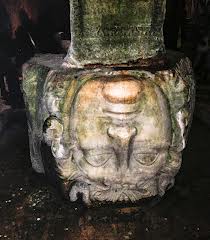By Fügen Yıldırım
Is she a monster petrifying those who look at her, or an innocent young maiden who, once upon a time, was making goddesses jealous with her beauty? Are we perhaps being unjust towards mythology’s female anti-hero with her hair made out of snakes?
A round and relatively big face, well-shaped slightly opened lips, droopy eyebrows as if she was sad, and sorrowful eyes glazing at a direction outside the scope of our sight… And a fullness of hair hanging down in curls. Taking a closer look, you realize that those are not hair curls, but a flock of curly snakes. Placed at the entrance of Didyma, Anatolia’s largest and richest Ionian sanctuary containing a Temple and Oracle of Apollo, this stone-carved head figure may appear scary to some, but remind others of a tragic story. The hero of the story is a figure having acquired a special place on mythology’s fertile soil, as the female monster whose ugliness was turning onlookers gazing directly upon her to stone. Indeed, Greek mythology is endowed with a vast variety of figures, the Olympos gods, the lesser gods, the semi-gods, gods living in oceans, those living in the underground, and the monsters, a multitude of important, less important, immortal and mortal, neither divine nor human creatures of that universe… The Gorgons were three sisters belonging to this group of in-between monsters living on earth and among them, the only mortal was Medusa; this situation would inevitably bring her story to a tragic end.There are different versions of Medusa’s story in mythology, but the common features in this variety are that Medusa was decapitated by Perseus, son of Zeus and Danae, daughter of Akrisios, the King of Argos, and that Pegasos, the winged horse and the golden-sworded giant, Khrysaor were born from Medusa’s blood…
Athena’s rage Let us now grasp the story of Medusa who is at the origin of the expression “being petrified by fear”. A story which might lead us to feel sad about her rather than being afraid. Athena, the favourite daughter of Zeus was jealous of Medusa who was originally a ravishingly beautiful maiden, “the jealous aspiration of many suitors.” She served as priestess in Athena’s temple, but when the “Lord of the Sea” Poseidon engaged in sexual intercourse with her (or raped her rather) in Athena’s temple, the enraged and jealous Athena found this situation demeaning for her and, choosing not to punish Poseidon, transformed Medusa’s beautiful hair to serpents and made her face so ugly that the mere sight of it would turn onlookers into stone. Athena’s rage was not yet appeased and she persuaded and guided the hero Perseus to behead Medusa whose blood was spilled on the Libyan desert and turned into snakes. Perseus left taking with him Medusa’s head. Athena presented two drops of Medusa’s blood as gift to the king of Athens, Erekhtheus. One of these two drops was a deadly poison, the other an elixir healing all diseases. Promised head Here is a story extending in length as the intertwined chain of events develops… In Greek mythology, stories are linked to each other and get often intermingled. Such is the case of Perseus’ story in which Medusa’s tragedy appears as an episode at a certain juncture.
The story of Perseus develops as follow: Akrisios, King of Argos learns that his grandchild to be born would kill him one day. When his daughter Danae gives birth to a son, he locks his daughter and his grandson Perseus in a trunk which is thrown into the sea. A good-hearted fisher Diktys and his wife save Danae and Perseus from their trunk and the two live together with the fisher’s family for many years. The brother of Diktys, Polydektes, who is the king of Seriphos, decides to marry Danae and preparations are being made for their wedding. Perseus must give a wedding present to the king but he has nothing. The king tells him that what he wants the most is the head of Medusa, the only mortal of the three Gorgon sisters… Perseus leaves to fetch the Gorgon’s head for offering it to King Polydektes as a gift. In his conquest, he receives a mirrored shield from Athena, winged sandals from Hermes, a sword, and Hades ‘cap of invisibility. Athena points out Medusa in her sleep to Perseus, as being the only one of the three Gorgons who is mortal, and Perseus is able to slay her with the sword he received from Hermes, while looking at the reflection from the mirrored shield he received from Athena, thus avoiding to be turned into stone, and places the head in his magic case. The two other immortal Gorgon sisters, Stheno and Euryale wake up to their sister’s screaming and begin to chase Perseus who puts on the cap of invisibility he received from Hades and disappears. Angry, the Gorgons return to their island. Medusa dies but Perseus’ story continues. According to a different version, Perseus uses Medusa’s head as a weapon until he gives it to the goddess Athena who decorates her shield with it. There is also one version according to which, Medusa was pregnant by Poseidon when Perseus beheaded her, and that Pegasus, the winged horse, and Khrysaor, the golden-sworded giant, sprang from her agonizing body.
Pearl of the Apollo Temple
Medusa known in mythology, for her power to petrify her onlookers, has also an important place in present-day literature and cinematography as an anti-hero reference. She is, among other, the most precious symbol of the Apollo Temple in Didyma. Due to the strong powers attributed to her, it is no wonder that her various depictions were used in reliefs as a protective symbol against evil forces. It is also due to its believed protective power that the stone-carved Medusa head is present at the entrance of theTemple and Oracle of Apollo in the sanctuary of Didyma. One comes across a number of incomplete Medusa figures in the temple as well.
Amongst the three mythological Gorgon sisters, the most unfortunate was certainly Medusa… While people in the Antique Age hoped being protected from evil by her, she herself had unfortunately not been able to protect her own head from Perseus. Let us decide now, are we going to regret her tragic story or are we going to be afraid of her? Better let us forget about such choice and enjoy the charm of the fantastic stories emanating from the fertile soil of mythology.
Medusa heads at the sunken cistern
Two illustrious examples of the figures known as Gorgon or Medusa heads are located at the Sunken (Basilica) Cistern near the Hagia Sophia in İstanbul. Located in the northwest corner of the cistern the bases of two columns reuse blocks carved with the visage of Medusa. The origin of the two heads dated to the IVth century AD, is unknown, though it is believed that the heads were brought to the cistern after being removed from a building of the late Roman period. There is no written evidence which suggests that they were used as column pedestals previously. Tradition has it that the blocks are oriented sideways and inverted in order to negate the power of the Gorgons’ gaze. However it is also supposed that they were placed sideways and upside down only to be the proper size to support their columns.
On the other hand, it is said that many Byzantium era sword handles and columns were engraved with her head upside down in connection with her believed protective power.
This article has originally appeared in “Müze” Magazine, published quarterly with the contributions of the Ministry of Culture and Tourism. We would like to thank TÜRSAB Museum Enterprises for sharing this piece with Istanbul Digital Platform followers.




















